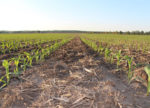Advertise Follow Us
Articles Tagged with ''No-till''
No, No, No... ‘He Chisel Plowed My 30-Year No-Tilled Ground’
It may take 6 years to return this long-term no-tilled ground to the superior soil quality it enjoyed before this tillage fiasco took place.
Read More
No-Till Farmer Influencers & Innovators
[Podcast] Compaction and Controlled Traffic with Randall Reeder
In this episode of the No-Till Farmer Influencers & Innovators podcast, brought to you by Topcon Agriculture, No-Till Farmer editor Frank Lessiter talks with Randall Reeder, who has done years of research on ridge till, strip till, no-till and conventional tillage through his work at the Hoytville Research Station in northwest Ohio.
Read More
Minimal Tillage, Cover Crops Work Together to Improve Soil Health and Hold Nutrients
Using no-till and strip-till along with cover crops can set your soils up for improved water infiltration and soil biological activity while maximizing nutrient resources.
Read More
Strip-Till Conversion Mellows Tough U.K. Soils
Turning to a modified strip-till setup that includes cover crops, Alex Shutes is saving time and money and seeing improved soil conditions with little or no yield drag.
Read More


.png?height=125&t=1731942302&width=150)









